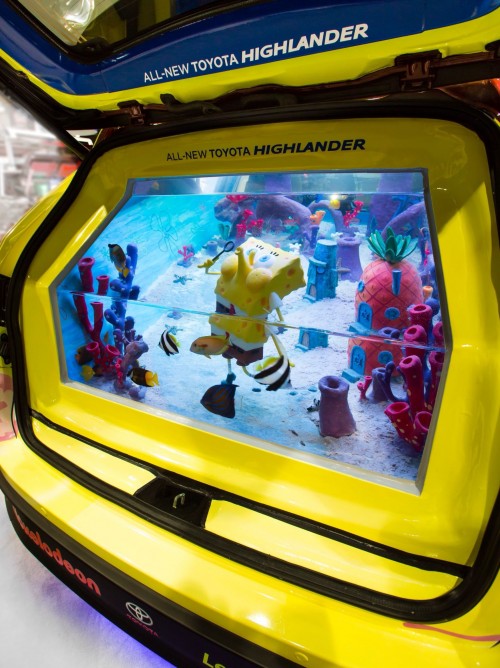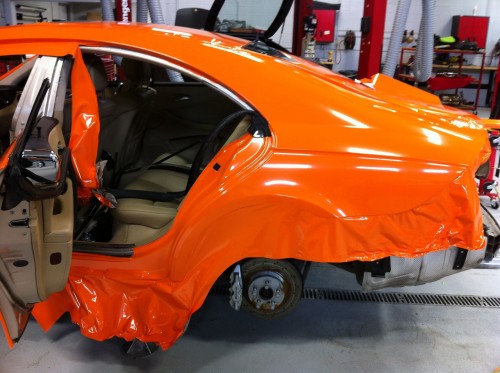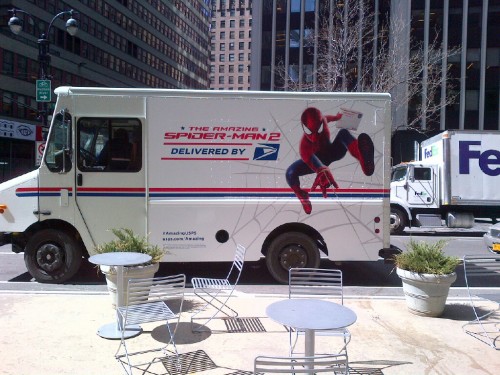Vehicle Graphics: Perfecting the art of the wrap
by all | 5 July 2014 1:30 pm
 [1]
[1]Photos courtesy Roland DGA
By Peter Saunders
Identity Brand, a graphics company, teamed up last year with Acrylic Tank Manufacturing (ATM) owners Wayde King and Brett Raymer, hosts of the Animal Planet TV series Tanked, to create a custom-wrapped 2014 Highlander sport utility vehicle (SUV) for Toyota. Dubbed the ‘SUV-aquarium,’ it featured a fully functional 3,028-L (800-gal) saltwater fish tank, custom-fitted within the rear seat and cargo area, which required a built-in overflow filtration system, sterilizer, ultraviolet (UV) filter and temperature regulator. The exterior, meanwhile, was wrapped with graphics inspired by the popular kids’ TV series SpongeBob SquarePants and produced using a Roland DGA VersaCamm inkjet printer/cutter. Upon the project’s completion, the tank was filled with about 115 fish, representing 32 species.
“Thanks to a skilled group of professionals and the capabilities of specialized equipment, the result was an extremely happy group of clients,” says Phillip Dominguez, owner of Identity Brand.
While this eye-catching project was truly one-of-a-kind, it exemplifies the need for great precision at every phase of vehicle wrap projects, including design, printing and installation. Once ATM’s tank was installed, Dominguez’s crew had to match client colours from Toyota and Nickelodeon (which produces SpongeBob) flawlessly.
“Even though we printed the hood and rear a day after the side install, there was no variation between the colours,” Dominguez says.
Toyota’s SUV-aquarium appeared on the March 7, 2014 episode of Tanked after touring automotive events, including the 2013 Specialty Equipment Market Association (SEMA) Show in Las Vegas, Nev.
Developing best practices
Facing higher client expectations, it has been vital for the sign industry to develop best practices for vehicle graphics, particularly full-body wraps.
 [2]
[2]Toyota’s graphic-wrapped ‘SUV-aquarium’ featured a fully functional saltwater fish tank.
“Wrapping vehicles may be a common practice these days, but that does not mean it is easy,” says Jeff Stadelman, marketing manager for Mactac, which produces pressure-sensitive vinyl for the graphics industry. “Even experienced designers, printers and installers make mistakes or cut corners in an effort to speed up their processes. The impact can be seen either immediately or over the lifespan of the graphics.”
As Stadelman points out, the graphic design phase is key. Unlike most printed graphics, which are installed ‘flat’, vehicle wrap designs must account for complex contours, curves and rivets.
“Designers need to think in three dimensions,” he says, “accommodating for areas that will require extra material, such as door handles. And any messaging needs to be easily viewable and unobstructed by corners, adjoining side panels and mirrors.”
Printing and lamination
For printing wrap graphics, Stadelman emphasizes the importance of a clean, low-traffic, well-ventilated environment with controlled humidity between 40 and 60 per cent and optimal temperature between 21 and 24 C (70 and 75 F). This will help keep debris, dust and dirt away from the printheads and the media. Printer operators should wear gloves when handling the media, to avoid transferring oils and fingerprints.
“Static electricity can also affect how ink lays on a substrate, as it attracts dust and dirt,” he says. “Avoid carpets and rugs in the printing area and consider using ‘static string’ to dispel it cost-effectively.”
Another important step is choosing the right substrate. Many types of vinyl are available, such as marking films intended for decals, bubble-free films for full-body wraps and perforated films for windows, each of which will entail its own ‘print profile,’ including how much heat to apply, ink limits and International Color Consortium (ICC) data.
The nature of the printer, meanwhile, will affect drying times after printing.
“With solvent-based and ‘eco-solvent’ inks, it is essential to allow plenty of drying time, typically 24 to 48 hours, with sustained airflow to all areas,” says Stadelman. “Failure to do so can contribute to stretchy vinyl and soft, gummy adhesives when solvents trapped in the vinyl migrate. Ultraviolet-cured (UV-cured) and latex inks, on the other hand, are ready for the next step right off the printer.”
The next step is overlamination, to protect the graphics.
“Wrap films with a laminate can last up to five years, which seems to be the industry standard,” says Molly Waters, technical specialist for Avery Dennison Graphics Solutions, another vinyl substrate manufacturer, “but some thinner laminates drop to four-year durability and most customers don’t balk, as their vehicle leases tend to be for just three years anyway.”
Graphic longevity is variable, however, since some areas of a vehicle are more susceptible to degradation than others.
“In most cases, the horizontal surfaces—such as the hood and roof—will have the toughest challenge,” says Stadelman.
“The sun beats down on those areas,” Waters adds, “so even a 10-year film can go down to two-year durability.”
In response, some manufacturers have designed premium laminates specifically intended for use on horizontal sections of vehicle wraps.
 [3]
[3]Unlike most printed graphics, which are installed ‘flat’, vehicle wrap designs must account for complex contours, curves and rivets. Photos courtesy Mactac
Colour changes
While there have been gradual improvements to printable substrates and laminates for vehicle wraps over the years, most of them are now well-established in the market. Today, more innovation is taking place with so-called ‘colour change’ films, which serve as an alternative to paint for a clientele of auto enthusiasts. New colours and textures continue to be released.
“Colour change films have been available in Europe for 10 years, but the original ones weren’t repositionable, as there were no air-egress capabilities back then,” says Paul Roba, technical manager for Avery Dennison, “so it used to take three to four days to install a wrap, compared to one day now.”
Even now, however, a steady hand and nerves of steel are called for, as any installation errors will be all the more noticeable to the client than with a graphic wrap.
“Some installers take the car apart to wrap each component,” says Roba.
“Customer expectations are higher for colour-change wraps than for printed graphics,” Waters agrees. “A print can hide mistakes. For a solid colour change, you need a stronger skill set. Some high-end installers even wrap the door jambs. The customer base is willing to spend a lot.”
 [4]
[4]Beyond printed graphics, innovation in ‘colour change’ films has brought vehicle wrapping to a new clientele of auto enthusiasts. Photo courtesy Avery Dennison.
One reason for this willingness is, ironically, the temporary nature of the medium.
“It’s economy-driven,” says Waters. “If you repainted a car in a cool matte metallic blue, it would devalue the vehicle—but with a wrap, you could go back to the original colour before reselling the car.”
Optimizing installations
While the material, printer and lamination markets for graphic wraps have matured, installation remains a key differentiator for sign shops, as it still depends heavily on individual training, skill and technique.
Lowen Color Services was recently commissioned to install graphics on more than 200 vehicles per week at 35 locations when the U.S. Postal Service (USPS) ran a marketing campaign in major cities with Sony Pictures Entertainment (SPE), to jointly promote priority mail services and SPE’s big-budget superhero movie, The Amazing Spider-Man 2. Each application was completed on-site through a national network of Lowen-certified and 3M-preferred installers.
“We were excited when USPS approached us with this significant task,” says Roger Borth, Lowen’s general manager (GM). “We are always eager to undertake very large projects with expedited lead times.”
For the high-profile marketing campaign, which began in mid-March and will run until the end of May, Lowen printed the fleet graphics on a 3M Commercial Graphics material designed for easy removal afterwards, returning each mail truck to its original appearance.
Surface preparation
One of the first steps that can significantly affect the quality of a wrap job, as Mactac’s Stadelman points out, is vehicle surface preparation.
“Even if a surface doesn’t look dirty or wet, cleaning is necessary,” he says. “Always read the directions for the specific vinyl being applied.”
Basic surface preparation begins with a soft, lint-free cloth and a solution of detergent and water to remove organic contaminants, such as dirt or dead insects. Next, with proper ventilation and personal protective equipment (PPE), a solvent-based cleaner should be used to remove petrochemical contaminants, such as grease, waxes or oils. Finally, the vehicle should be wiped down with water-diluted isopropyl alcohol (IPA) and allowed to dry.
Tools for the job
Basic installation tools include squeegees for applying films, a razor knife for trimming panels, a bubble releaser, scissors, masking tape and a heat gun.
“Other options to consider are a small pry bar to remove adhesive emblems, magnets to hold graphics in place while you test-fit them for design integrity, a grease pencil for creating hash marks to help with positioning and a propane torch for faster application,” says Stadelman.
 [5]
[5]Some installers will take a car apart, so they can wrap each component individually.
Similar to printing, the wrap should take place in a controlled environment. Appropriate temperatures range from 16 to 27 C (60 to 80 F). And while there is no need to take the vehicle apart as some colour-change specialists do, easily removable components like wipers, antennas, licence plates, washer nozzles, side mirrors and lights should be set aside.
Techniques
Stadelman recommends starting at the back of the vehicle and working forward, as any overlaps should face the back, to minimize the chance of damage from rain hitting the vehicle from the front when it is driven. The tape or magnets can hold graphics in place while working on each section.
“You can apply a strip of tape across the middle of the graphic to create a hinge,” says Stadelman. “Next, bend half the graphic back, exposing the underside, and pull the liner off that half. Once the adhesive is uncovered, apply the sticky half using a squeegee. Then remove the hinge and repeat for the other half. Use the heat gun only when needed to stretch the film in complex areas or to recondition it if it gets stretched out of shape.”
Heating becomes important again after the graphics have been applied.
“Post-heat all edges, seams, channels and stretches at 104 C (220 F),” Stadelman says. “This is necessary to reset the ‘memory’ of the media to its new shape.”
Cleaning and maintenance
Once a wrap has been installed, the adhesives will need time to cure completely before any cleaning. Avery Dennison’s Waters recommends waiting for two days, while Mactac’s Stadelman suggests at least three days before hand-washing and a week before machine- or pressure-washing.
Hand-washing is the preferred method, avoiding unnecessary abrasion through scrubbing. Soft cloths, mild detergents with a pH value between three and 11 and non-abrasive cleaners are recommended, with no strong solvents or alcohols. To keep the wrap looking its best, Waters recommends cleaning it at least once a month.
“When people take care of wraps, they’ll last longer,” she says. “If dust were to collect over time and then get hot in the sun, for example, it could burn right into the wrap.”
A polish or wax will also help extend a wrap’s useful life, so long as the wax does not contain petroleum distillates. Matte-texture films should never be waxed, though, as the wax will cause unwanted shiny spots.
 [6]
[6]A USPS marketing campaign for The Amazing Spider-Man 2 involved installing graphics on more than 200 vehicles per week, at 35 locations. Photo courtesy SPE
Practice makes perfect
With all of these stages in mind, vehicle graphics may seem overly complicated, but many sign shops have found success in this market, by taking a careful approach and testing new products and techniques as they arise before implementing them in actual jobs.
“As with anything, practice makes perfect,” says Stadelman. “Always measure twice to avoid mistakes. Graphic applications take a while to master and vehicle wraps are not typically quick jobs. Ensure you allow yourself enough time.”
Many training courses are available to the industry. 3M offers classes in conjunction with Mimaki, a printer manufacturer, that address vehicle wrap application and removal, while Avery Dennison partners with another printer manufacturer, Mutoh America, and resellers like Proveer to organize classes and workshops taught by renowned wrap installer Justin Pate.
“I use the techniques and tricks I learned from Justin every day,” says Sean Tomlin, owner of Designer Wraps. “He showed us specific tips, like trimming corners properly, to improve the quality of our installations.”
“You need to pay attention to quality to get repeat business in this field,” says Avery Dennison’s Roba. “You can use tools like classes and videos to get better.”
With files from Roland DGA, Mactac, Avery Dennison Graphics Solutions and 3M Commercial Graphics. For more information, visit www.rolanddga.com[7], www.mactac.com[8], www.averygraphics.com[9] and www.3mgraphics.com[10].
- [Image]: http://www.signmedia.ca/wp-content/uploads/2014/05/Image_3_Aquarium_SUV.jpg
- [Image]: http://www.signmedia.ca/wp-content/uploads/2014/05/Image_2_Aquarium_SUV.jpg
- [Image]: http://www.signmedia.ca/wp-content/uploads/2014/05/JT5529MBF_LF3398_SnakeCar_003.jpg
- [Image]: http://www.signmedia.ca/wp-content/uploads/2014/05/IMG_6543_5.jpg
- [Image]: http://www.signmedia.ca/wp-content/uploads/2014/05/image_2.jpeg
- [Image]: http://www.signmedia.ca/wp-content/uploads/2014/05/CourtesySonyPicturesEntertainment.jpg
- www.rolanddga.com: http://www.rolanddga.com
- www.mactac.com: http://www.mactac.com
- www.averygraphics.com: http://www.averygraphics.com
- www.3mgraphics.com: http://www.3mgraphics.com
Source URL: https://www.signmedia.ca/vehicle-graphics-perfecting-the-art-of-the-wrap/